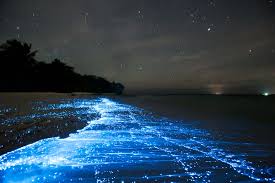Welcome back friends!
This week, as promised, I wanted to talk about the bioluminescence, often called "stars in the seas." What it is, how it works, and where to find it. This is always something I recommend to others if they love nature and need another bucket list adventure (who doesn’t, right?) added to their agenda.
(These photos are linked to the site it was published on; Nu Bear does not own these photos, but we do hope to get some of our own great shots soon!)
So, bioluminescence? What is it? It is a chemical reaction that is seen in many organisms. For example, anglerfish, jellyfish, fireflies, glow worms, fungi, and dinoflagellates are all organisms that produce a bioluminescence. In a handful of places around the world, phytoplankton and dinoflagellates erupt with bioluminescence at night! The light they give off is caused by a chemical reaction within them, and when pressure is put on their cell walls, the reaction kicks in. In these areas, it is typically more common to see this occurrence in hotter months with longer days (In Florida, for example, this would be July- early September). This is because they reproduce in blooms, so the warmer the water, the more phytoplankton/dinoflagellates, although they can be seen in cooler water and year round. It has been described as feeling like you’re in Avatar or Moana, with the everything lighting up brightly all around you. It surely is a phenomenon I love to see as much as possible in Florida, and I am always surprised learning about how many people have never even heard of it!
How does one get photos of it?
Well, photos can be very difficult to capture without a camera that does well with low exposure and . The photos above are accurate depictions of what I have seen bioluminescence, but are not my photos. I just go for the memories and to be in the moment. Some cameras that can capture this are the iPhone 11, Sony a6000, Sony a7SII, Canon EOS 6D Mark II, and any other DSLR camera and lens that can shoot in a higher range of settings. Try to open the aperture, use higher ISO, and play around with different ranges of exposure settings, based on where you're shooting, desired outcome, and darkness outside.
Some places to see this phenomenon:
United States
Puerto Rico
Costa Rica
Colombia
Grand Cayman
Jamaica
Belgium
United Kingdom
Taiwan
Japan
Thailand
Cambodia
Vietnam
Indonesia
Australia
For a more detailed list, feel free to use the chat feature on our website, message us on social media, or email me at hello@nu-bear.com.
Glow on!
Until next time,
Tiki








Comments